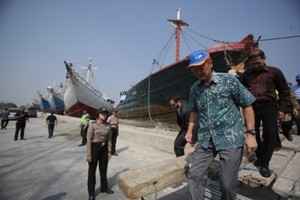
The World Bank Group has pledged up to US$12 billion in new financing to Indonesia for use in improving the country’s maritime logistics and port infrastructure so as to lower costs and boost competitiveness.
The financial support will be provided over the next three to four years, including funding for seaports, access roads, and other projects that aim to improve maritime logistics and connectivity.
Indonesia reportedly has a $600-billion infrastructure gap in the next five years, and maritime and logistics infrastructure needs total $50 billion in investments in the next five to 10 years.
“We are going to use the full weight of the institution, all of the creative ways of providing advice and financing, to support Indonesia’s vision of building what could turn out to be a maritime super highway, which could boost economic growth every year by two per cent,” said World Bank Group president Jim Yong Kim during his visit to the country late last month.
The operation of most seaports in Indonesia is set back by inefficiencies that significantly increase logistics costs for businesses and consumers. Logistics costs in Indonesia amount to 24% of gross domestic product (GDP), which the financing group said is an enormous tax on the country’s economic growth.
If, like Thailand, Indonesia were to reduce its logistics costs to 16% of GDP, it is estimated to save government, businesses, and households $70 billion to $80 billion a year, said the World Bank in a report.
It cited as an example Tanjung Priok, Indonesia’s most advanced and efficient port, which despite its heavy investment in modern equipment and improved management systems, still underperforms compared to similar ports in neighboring countries.
“After a container is unloaded at Priok port, it sits for six days before it leaves the port gates—this so called ‘dwell time’ is twice as long as dwell time in Malaysia and five times longer than Singapore.”
Other Indonesian ports take even longer to move containers. Producers pass those higher costs on to consumers. Due to port inefficiencies and poor port-hinterland connectivity, many basic commodities in eastern Indonesia are twice as expensive as in Java.
Thus, it is often cheaper to import oranges from China than for Indonesian growers to sell outside of their own island. Inversely, fishermen in Papua—the island at the far east of Indonesia—can only sell their top-grade tuna for $4 a kilo on the island, less than one-tenth of the price it can fetch abroad.
At the same time, truck traffic between facilities is often gridlocked. It can take six hours to move a container from the Cikarang industrial area to Tanjung Priok—a distance of only 35 kilometers. So part of the solution is to improve the land component of the logistics chain.
The World Bank Group, a family of five international organizations that provides loans to developing countries, said it aims to work with all relevant public and private stakeholders in Indonesia to address the Southeast Asian’s maritime logistics and connectivity challenges in a holistic way.
“Targeting single interventions without looking at the entire supply chain will not bring the much needed improvements,” it added.
Indonesian President Joko Widodo last year unveiled an ambitious plan to build 24 seaports over the next five years in a drive to make the archipelago a global maritime axis.
Photo from World Bank Group





